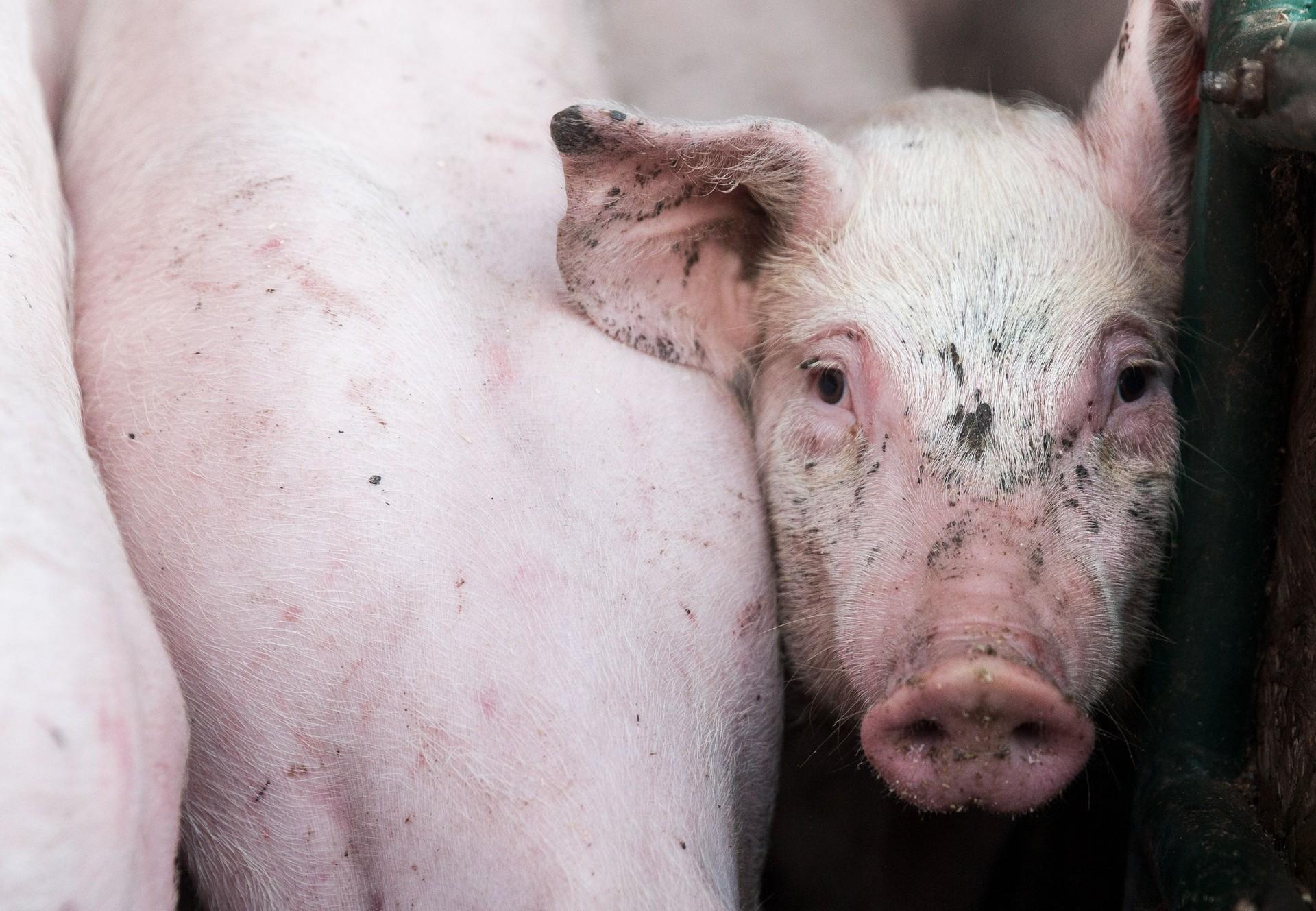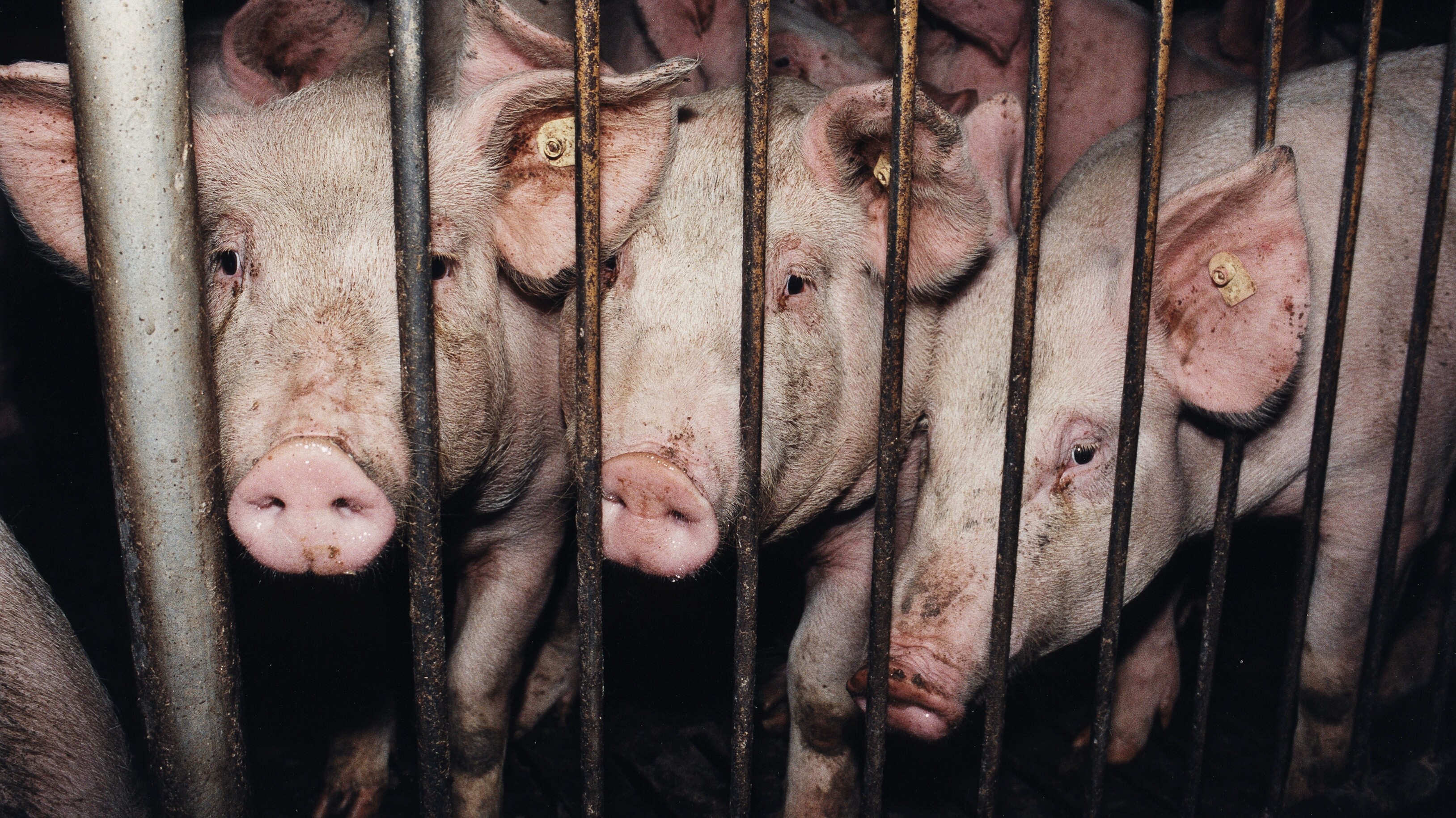
Pig Husbandry
The curious and sociable animals cannot perform their natural behaviors on factory farms
Pigs are among the most intelligent animals and have an exceptional capacity for learning. There have been many studies done on their social intelligence, cooperation, object permanence and other amazing cognitive abilities1, all proving the animal's greatness. Since they cannot sweat, they like to take mud baths on hot days in order to cool down. In natural conditions, they spend a lot of time exploring their surroundings, and, as social beings, they live in larger groups. A female pig – a sow, will only isolate herself shortly before giving birth and builds a nest. After the first few days, the sow starts to leave the piglets in their nest to go look for feed and starts with the slow integration back to the herd2. If she has the option, the sow will then nurse the piglets for about 15 weeks, but only once an hour for a few minutes. The remainder of the time, both sow and the piglets, will spend socializing with other members of the herd. However, most pigs suffer under intensive farming conditions and do not experience this kind of a life.
So far, intensive pig farming has hardly considered any of the animals' natural behaviors – on the contrary: their needs are suppressed, they are isolated from the group and cannot move around enough. They cannot live out important basic needs such as personal hygiene, exploration, foraging, social needs, or even nest-building behavior. The consequences are severe physical and psychological damage.

Bulk pork: cheap meat at all costs
Whether processed into a sausage, a cutlet or a schnitzel, pork is the most consumed meat worldwide. Globally, an average person consumes about 16 kilograms of pork per year3, but it depends highly on the region. The biggest consumer of pork in the world is Hong Kong (59 kg per person per year), followed by Poland, Spain, and Germany (50-55 kg of pork per person per year, respectively)4. On the other hand, there are many countries where pork consumption is practically non-existent.
There are almost 147 million pigs in the European Union. In order to meet the increasing demand for meat, more than 256 million pigs were slaughtered in the EU in 2019. Currently, Spain is the largest pig producer in the European Union, with yearly pig population of more than 31 million, followed by Germany with 26 million. Worldwide, the biggest producer is China (310 million pigs per year), followed by the EU and the US (78 million5). But hardly any pig is ever lucky enough to stand on a green meadow. The total number of pig farmers is falling, but at the same time the farms are getting bigger. Most of the pigs have to live in factory farms – facilities with more than 400 animals6.
For cost reasons, pig production is more and more organized in terms of production. Specialized farms only keep sows for piglet production, the young animals are fattened in other farms before they may be moved back to another barn at the final fattening phase. A pig is therefore often loaded onto many different animal transports in the course of its life. There are more and more integrated farms in Spain, where they have all stages of production on one site, which means transport is not an issue anymore, but that only means there is even more pigs together on one farm (which causes even more issues with regards their welfare).
This is how pigs suffer in intensive animal husbandry
Modern pig hybrids are selected for high daily weight gain within the shortest possible fattening period. In order to meet the consumers’ desire for cheap meat and to consequently keep production costs as low as possible, the equipment in the stables is maximally reduced in space and quality. The design is prioritized towards fattening pigs as cheap as possible, and not according to pig’s basic needs.
The improper housing of the animals leads to stress, and makes the pigs susceptible to disease, which leads to mortality and to an increased use of medication. Common diseases include pneumonia, feet problems and stomach ulcers. After about 160 to 180 days of life, the pig, with a live weight of 110 kg, is ready for slaughter and is sent on its last journey to the slaughterhouse.
Weak piglets are often killed
As the Landrace breeds became more popular – a breed that gives birth to more piglets that they can care for - the piglets suffer as well. Usually, a sow has 12 teats (14 - 16 is also possible, but not very common), and animals of the Landrace breeds have more than 17 piglets per litter7. As a result, more piglets are born with a low birth weight (500 - 700 gram instead of 2 kilos). A sow cannot produce enough milk to support so many piglets, therefore weaker piglets need special care with supplementary milk or with the use of an additional nursing sow8. Due to time constraints, this is omitted if mismanagement occurs, and the weak piglets are instead sorted out and – often improperly – killed.
Piglet castration and tail docking without anesthesia
Behavioral disorders, such as tail and ear biting of other herd members, are the direct consequences of improper keeping and feeding. Instead of adapting the housing conditions to the basic needs of the animals, painful and life-changing interventions are carried out on pigs. Most common 'solution’ to tail biting is tail docking in week-old piglets, where a hot electrical iron or a scalpel/knife is used to cut or burn off the distal end of the tail, without the use of anesthesia. The wound is not treated afterwards, and the stressful procedure creates several negative consequences, like acute and chronic pain, as well as the loss of option for natural expression of behavior.
This is despite the fact, that the routine docking of tails in pigs has not been permitted anywhere in the EU since 19949. The European Commission has warned several Member States to comply with the applicable legislation but has so far been reluctant to take any penalizing, enforceable action. Here you can find out more about audits on animal health and animal welfare, carried out in your country.
Pigs use their tails to express their feelings, but they cannot do that if the tail is docked. In the picture above, you can see what different tail movements mean.
Another painful procedure for piglets is castration, mainly surgical, and without pain alleviation by anesthesia or analgesics. The reason: with intact boars, an unpleasant smell can occur when the meat is heated during cooking. However, the boar taint is very rare, and occurs mainly if animals are kept in inappropriate husbandry and hygiene conditions. Smell-contaminated meat could be sorted out at the slaughterhouse and processed cold, for example for sausages. But meat processors fear higher costs and consumer aversion, although some countries, such as the UK, run their pig industry with intact males for many decades already.
Crowded in the tight cages: crates for sows
Breeding sows have to give birth to as many piglets as possible and as often as possible, with fatal consequences for their health: an average of 50 percent of sows have to be prematurely sorted out and slaughtered annually due to fertility problems and health problems.
A breeding sow, that is nursing her piglets for half of her production life, is squeezed into a narrow metal cage during this time. This cage is only as big as the sow itself – she cannot turn around. Breeding sows are fixed in this crate to reduce the number of crushed piglets, due to insufficient space and a lack of nesting material. There are animal-friendly alternatives to the crate, such as free-farrowing stall, as used e.g. in organic or outdoor systems. Learn more about the problems with farrowing crates.
FOUR PAWS CALLS FOR...
...the end of cruel practices:
They are inducing fear, pain, and distress, thus diminishing the immune system, altering brain function and the natural behavior of animals.
- General ban on keeping sows in crates, across all countries. There are many animal-friendly alternatives to this, and the system should be adapted to the animal and not vice versa!
- Free farrowing systems (with protection against piglet crushing) in which the sow can build a nest, move, and turn around, as well as socialize with her piglets and peers.
- Limitation of an individual fixation to an absolute minimum (by the hour), e.g. for treatment purposes and veterinary interventions only.
- Ban (and more enforcement measures) on the painful mutilation procedures, like tail-docking and anesthetized castration.
- Highly intensive concentrate feeding must be avoided.
- Fully slatted flooring should not be allowed.
- Ban on breeding for extreme performance (e.g. for more teats per sow) - the well-being of the animal must be prioritized and the average number of piglets per litter must not exceed the number of teats.
…fulfillment of basic needs:
if neglected it leads to poor welfare states and therefore to suffering, acute pain, distress, fear, and long-term negative welfare states. Basic needs of pigs are:
- Pigs are a social species and must be kept in stable and appropriate groups – group keeping of sows and group farrowing should be a standard procedure. If group farrowing is not possible due to management reasons: temporary individual farrowing in movement bays (max. ten days) with protective devices (piglet deflectors) to prevent the piglet being crushed. After that, group reunification should occur, as it can be otherwise highly detrimental to their health.
- Long straw should be always available as nesting material in the farrowing area in the days before birth
- Pigs have a strong motivation for foraging, that’s ideally taking up most of their time budget in a day. Rooting is one of the most prominent and important part of foraging behavior and not being able to fulfill it, results in many different health issues (e.g. stereotypies).
- A diet, appropriate for pigs (with high fiber and forage content), is not only essential for maintaining their physical health (prevents the nowadays frequent stomach ulcers), but also gives them the possibility to express their natural foraging behavior.
- Sufficient lying space with dry and soft bedding is crucial – hard surfaces cause shoulder sores for the sows (due to their weight causing pressure on the shoulders and spine), and open wounds on joints in piglets (due to them constantly kneeling down to suckle).
- Appropriate soft flooring - pigs' claws are adapted to soft and swampy floor - hard floor surfaces cause feet problems, lameness, and bursitis
- Access to the outdoor area should be readily available, where the animals can experience the outside world and enrich their life – the animals are less bored and in control of their daily life, when they can experience different environments.
- The shelter should give protection from extreme weather conditions and have good air quality, with readily available water and food.
- Animals should be kept in good health and receive veterinary care if needed.
Source
2. Pork Getaway | http://porkgateway.org/resource/natural-farrowing-behavior-of-the-sow-and-piglets/
3. Our World in Data | https://ourworldindata.org/meat-production#which-countries-eat-the-most-meat
4. Our World in Data | https://ourworldindata.org/grapher/per-capita-meat-consumption-by-type-kilograms-per-year?tab=table&time=1961..2017
5. Statista | https://www.statista.com/statistics/263964/number-of-pigs-in-selected-countries/
6. EuroStat | https://ec.europa.eu/eurostat/statistics-explained/index.php/Archive:Pig_farming_sector_-_statistical_portrait_2014
7. Scielo | https://www.scielo.br/scielo.php?script=sci_arttext&pid=S1516-35982020000100402
8. Danbred | https://danbred.com/en/managing-high-litter-size-from-farrowing-until-weaning/
9. European Union Law | https://eur-lex.europa.eu/legal-content/EN/ALL/?uri=CELEX%3A32008L0120

